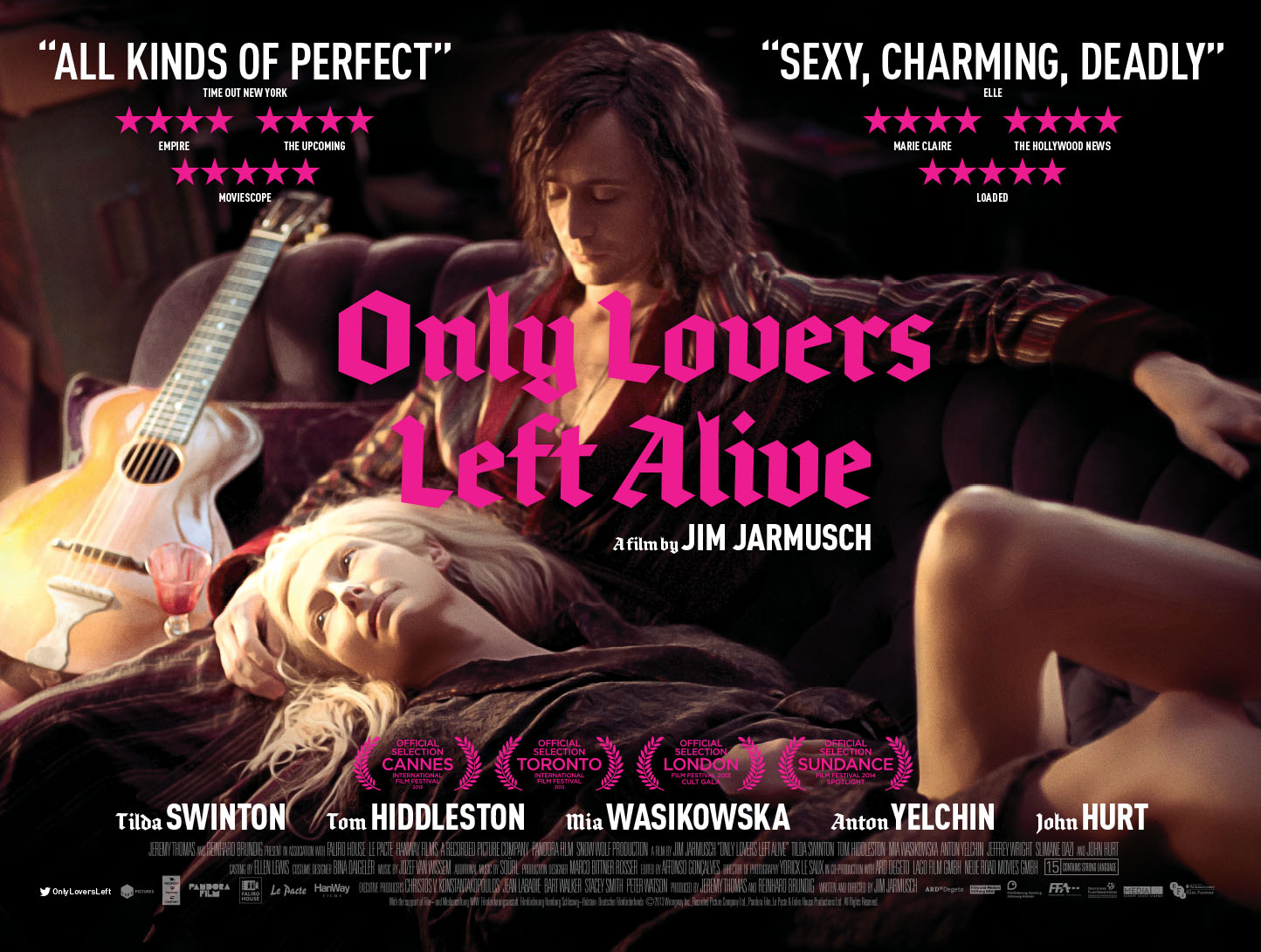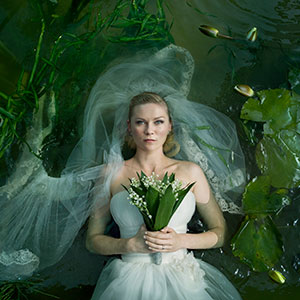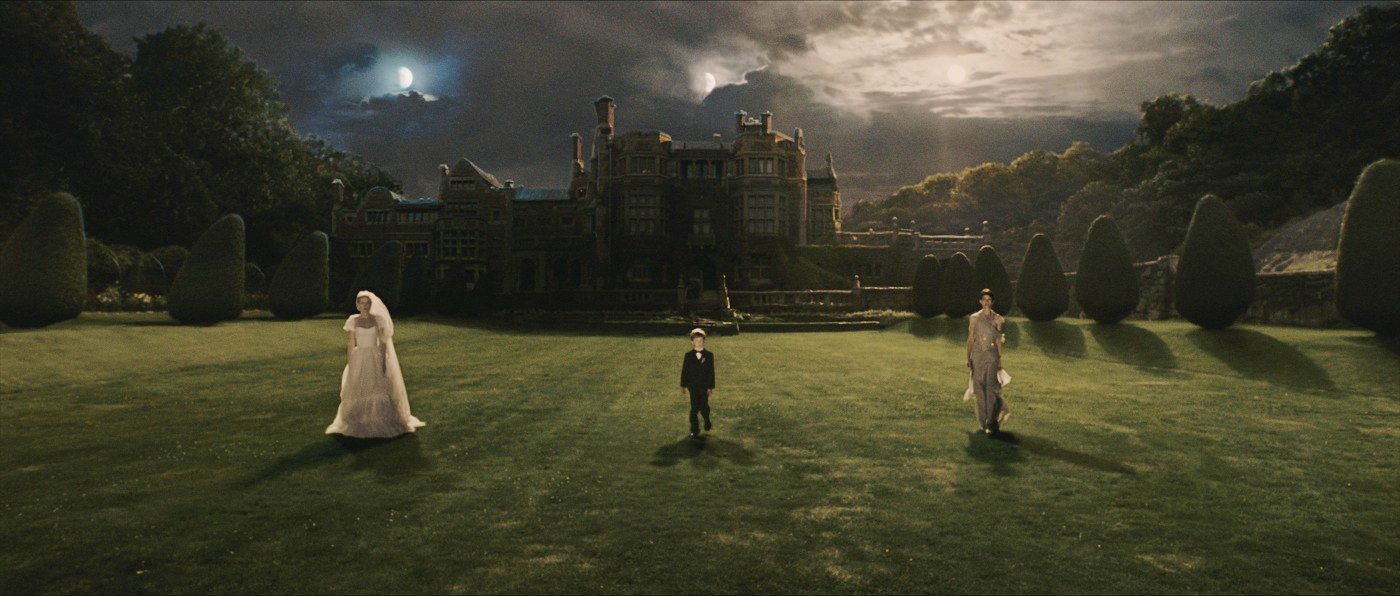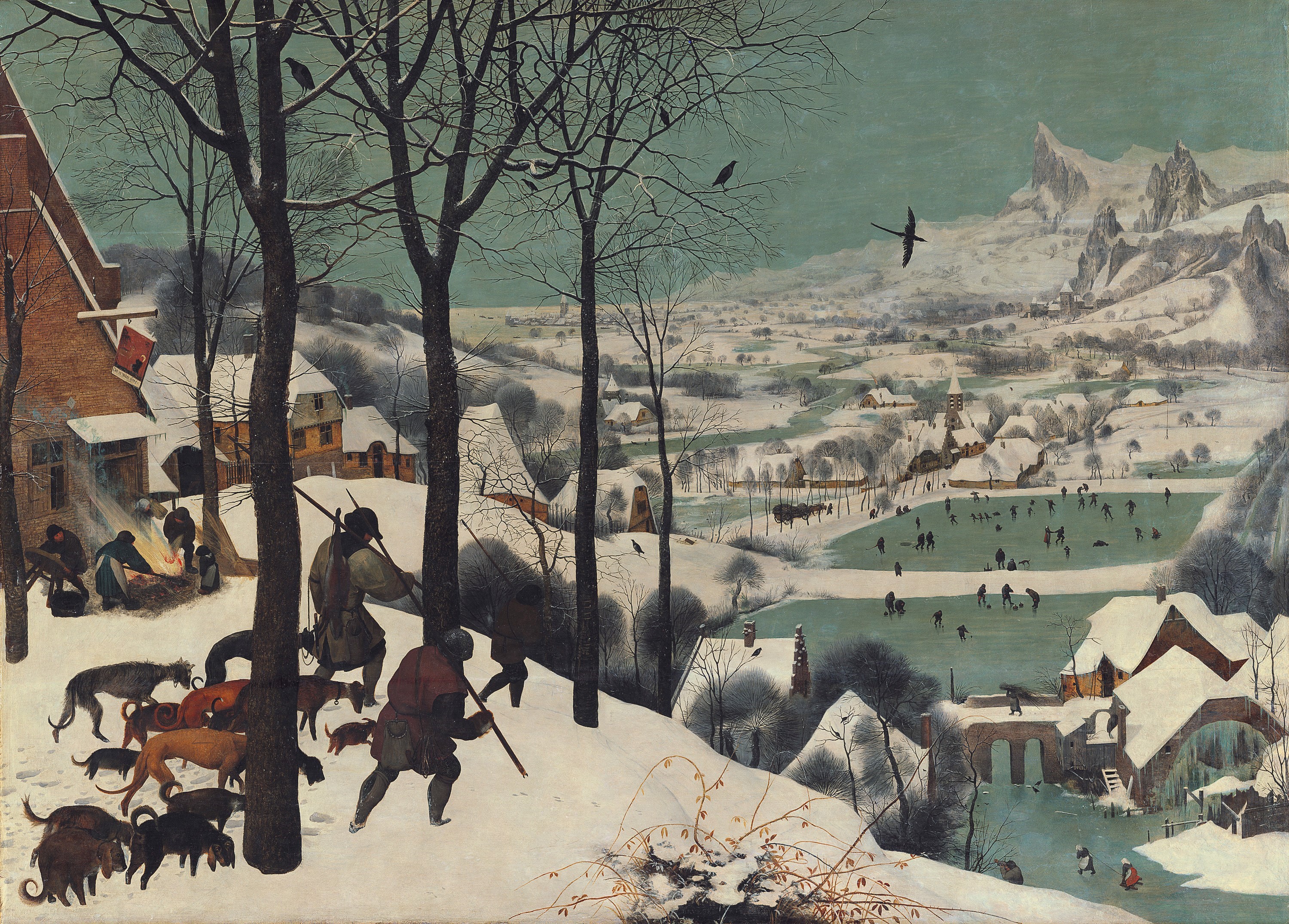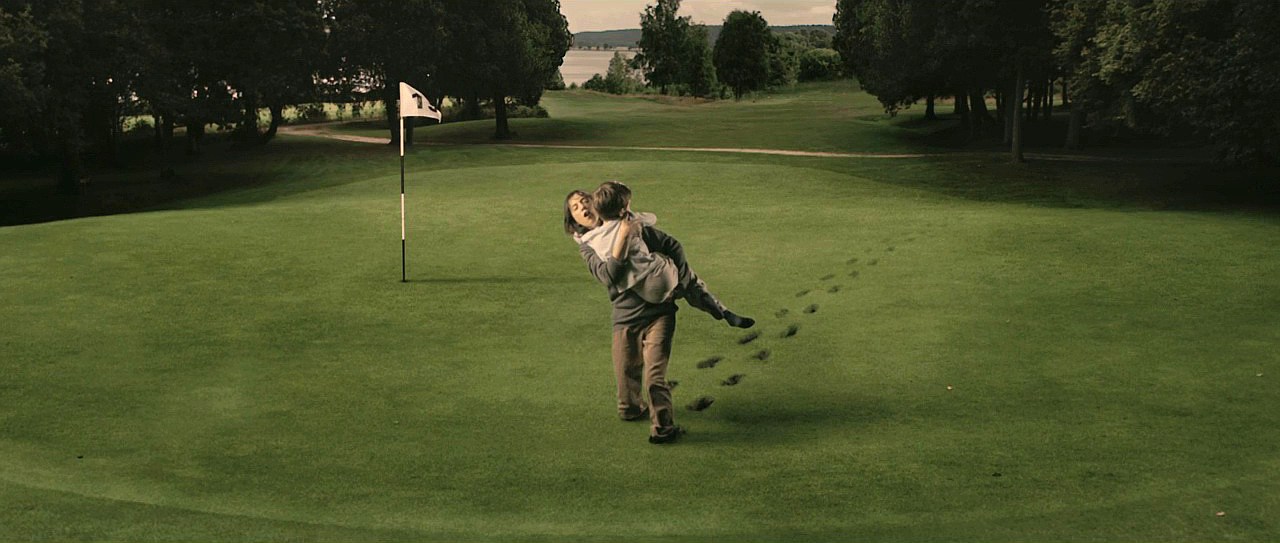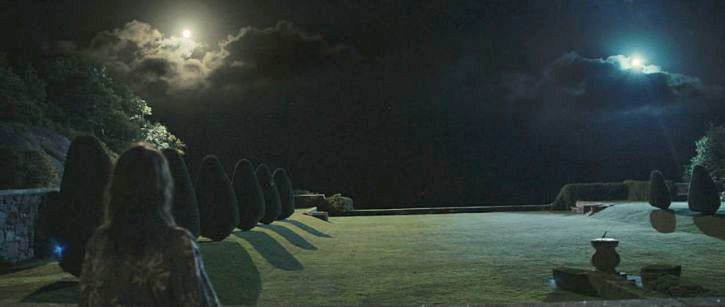
Only Lovers Left Alive is vampire romance for grown-ups. It’s the rare vampire film that tries to convey what it would actually mean to live for centuries, questioning the world around you and turning your nose up at everything human and mortal. The story spins out in an intoxicating swirl of music and high-culture; at the centre of it, a couple who can’t live without each other but don’t live together any longer. The titular lovers are shadowy figures lurking just on the edge of history, indulging in a tortured and eternal love, more believable and sexual than any of the recent rash of tween vampire lore.
The film takes ideas we’ve seen in films like Interview with a Vampire , Let The Right One In and Byzantium, and adds commentary on our modern world. What would an elegant immortal being who’s seen it all think of our quick consumer culture and digital devices that allow us to feel to connected to people continents away.
Plus, answers to the question many have wondered. What would vampires think of iPhones? Of Techno-music and videos on Youtube?
Sure to be a cult fav, Only Lovers Left Alive is dark and decadent, saturated by haunting rock music and an unshakeable air of impending danger. Indie-hero Jim Jarmusch wrote and directed this vampire tale, pumped full of wry, intelligent humor and some delightfully silly historical references with a stylized production as rich and decadent as it’s story. The Palm d’Or nominated film chronicles the reunion Adam (Tom Hiddleston) and Eve (Tilda Swinton), beautiful vampires who have been lovers for centuries and married several times. Recently, they have been living apart: him in a crumbling house on the outskirts of Detroit, her, swathed in silks in Tangiers.

Adam is your basic emo-rocker. He’s got the long, unwashed hair, shirts unbuttoned to his navel and the distaste selling out, but underneath, he has the face and sickly-sexual comportment of a romantic poet. Isolated in a town where no one seems to live anymore, he spends his days playing guitar and composing music he isn’t ready to show anyone. He only leaves his home to procure blood for a local hospital, where he struggles to control his thirst around bleeding patients. He relies on Ian (Anton Yelchin) to do errands, bringing him instruments and keeping the fans away. As the story begins, he is considering killing himself and asks Ian to bring him a wooden bullet.
Meanwhile, Eve is an ultra-sophisticated vaguely European jet-setter, drawn to exotic locals and excited by life. While Adam has his music, Eve has literature. In a scene any book lover would adore, she packs suitcases full of books for a visit to Detroit. She gazes over the texts, some medieval with woodcut illustrations, some in ancient languages, some modern, her faces enraptured at the beauty she sees. Her close confidant is Christopher Marlowe (John Hurt), the real author of Shakespeare’s plays, he keeps a picture of the bard on his wall to throw knives at.
It’s hard to imagine better actors for the lead roles. Swinton and Hiddleston both appear uncanny and otherworldly, in appearance, in the way they carry themselves and in the way they find they inhabit the film’s world, that they seem like members of some unknown species that includes only each other. Swinton in particular has never looks less human, she wanders around Tangiers like some strange white unicorn trying to take on human form.
It is perhaps too on the nose that they are Adam and Eve, but the names highlight the connection between them. They have a mystical connection that draw them to each other, highlighted by Adam playing guitar in Detroit while Eve dances in Tangiers as if she can hear it. Though they are not the first man and woman, through history they seem to be the only couple that always endures, their relationship only thing that will live on as empires come and go.

Adam and Eve are well-developed, each with their own separate but intertwining lives, passions and histories. They seem remarkably real for centuries old vampires, You can easily imagine them roaming around in the dark corners of a dying city. Though they live separate lives much of time, there is a magnetism that pulls them together when they reunite, seeming as if they each want to consume the other, breathe in their air and connect by running their hands along each other’s bodies just to experiences and remember each other. Their intimacy is tasteful and personal, suggesting that on top of sexual attraction, they just want to be near each other and as content to lie beside each other nude as they are to play chess together and eat blood popsicles.
It’s a very romantic tale, both in the modern sense and in poetic tradition. For all his protests, Adam is a romantic hero, lost in a desolate wasteland that mirrors the ravages of his soul. He has isolated himself in the dying city of Detroit, whose loss of the auto industry has made it a virtual ghost town. When Eve visits, he takes her on a tour of its wilderness, showing her where people used to live, taking her to an old gilded theatre falling into ruins. At home, his wall is covered in photographs and portraits of the dead luminaries he has known, so he can never forgot the temporary nature of human life, passing him by.
He is disillusioned with musicians and his old heroes, the scientists, dead and destroyed by the cultures around them. He sees science as destroying human lives, contaminating water with chemicals and blood with diseases and long ago stopped considering himself part of this humanity. He calls humans zombies and decides he can’t be around them anymore, disgusted by their fears of their own imaginations.
Eve is the light to Adam’s darkness, all in white while he’s always in black, yet remains a realistic character because of implied darkness of her own. Swinton plays Eve like an ethereal vision who can’t escape the weight on her shoulders, she always seems struggling to stay afloat. It is this weight and her passionate love for culture, the books she reads through while packing, the Shakespeare volume she sighs after finishing and the rapturous dancing and yen to explore, that keeps her from being a mere servant to Adam’s moods. Eve is so well in synch with the world, that she has slight psychic senses, able to intuit the age of a guitar just by touching it and maintaining a deep connection to the moon. She believes in living and experiencing as much as possible of each era that passes by. THough she is implied to be older than Adam, she is still able to appreciate lie and wax poetic about the lights and color, the dancing and friendship that are all part of the experience.
From her point of view, Adam’s depression is a waste, so she devotes herself to bringing him back into the world, reassuring him that even if the world is destroyed for humans, they’ll still be around. She resents that he treats her like a part in his story, a means to the end, rather than a real person to rely on when in times of need. She feels taken for granted like, he sees her as another one of the transitory zombies who will come into his life and leave it. Despite the specific references to thing like immortality, it’s not unlike the typical conversation between an ordinary couple in any other movies. The supernatural elements added to what is essentially a woman trying to help her depressed partner, serve to make the story larger in scope, more evocative of gothic conventions and tortured love and dangerous.

Jarmusch skillfully integrates modern technology into their ageless world experienced as just another culture’s momentary trends. He also includes references to both modern pop culture and ancient history without either seeming shoehorned in. Eve is as taken in with Jack White and David Foster Wallace as Mary Shelley and Marlowe’s ghostwritten Shakespeare plays, while Adam’s doctor disguise includes name tags like “ Dr. Faust ” and “ Dr. Caligari”.
Eve notes all the things she has been through and survived, the different cultures that seemed dangerous that she has watched die around her. She considers modern times no different, an age that any other, with its transitory values that will end and tries to enjoy our technology as part of the experience of this time and place. While Adam uses retro pieces of equipment and hooks his phone up to an ancient TV to talk, Eve is comfortable speaking on her iPhone’s Facetime and interacting with the outside world to make travel arrangements for the pair.
For all his speeches denigrating humanity, Adam has all too human concerns. He is attached to his possessions and secretive about his music, worried about it getting out before it’s ready. As a rock musician, his entire lifestyle and tortured-rocker identity is supported by human fans, ones who his complains about and just wants to leave him alone. While ethereal Eve believes in traveling light and replacing anything tangible, Adam is of the world and tied to his possessions.

About midway through and after a lot of anticipation, as Adam, Eve and Marlowe all had dreams about her, Eve’s sister Ava (a spacey-fairy Mia Wasikowska) arrives at Adam’s house decked out like a 60s groupie. Party girl Ava is invasive and impolite, entering uninvited, forcing her way into their dreams and into their house and to Adam’s annoyance, listening to his music without permission. There is a genuine big brother-little sister relationship between Ava and Adam, and as old as she is, she’s a teenager out to have fun, even if it means intruding on an important moment between the couple. She bounces around, jumping on the bed where the couple is sleeping, as if she is their child.
In addition, Ava is an even stronger force than Eve at drawing Adam out of himself. In one scene, Ava is enjoying a TV show that depicts Dracula dancing on psychedelic backdrops. While Eve comes and watches it with her, Adam, perpetually brooding turns off the TV and spoils their fun. In one hilarious moment, the women try to get Adam to go to a club with them. Though Adam insists he is not going to go, the next scene shows the three vamps in dark sunglasses at a hipster bar. Though meant as a joke here, his brooding can become unintentionally humorous at times.
After the night out, Ava bites Ian, killing him and destroying much of Adam’s prized possessions. Ava’s feeding off Ian is played as a clear metaphor for sex, based on the language she uses: “I didn’t mean to do it, but he was so cute. I couldn’t help myself.” It’s suggested that Ava is wild and unable to control her sexuality, and with that it mind it’s a little uncomfortable that she is berated for it. Unlike Adam and Eve, who have figured out ways of constraint, subsisting through hospitals and Marlowe’s connections, she refuses to live by a set of rules and is punished for it when Adam kicks her out of the house.
Scenes of the vampires drinking blood are shot similarly to how scenes of drug use are often filmed, with characters rising in the air and come back down, sighs of euphoria on their faces. This comparison makes a lot of sense within the film as the characters appear perpetually strung out, floating around their environs.

There’s something dream-like and hazy about the film, like the domestic drama at its core, the basic story of a depressed man and his bon vivant wife visited by her annoying sister at an inconvenient time that causes them to reassess their relationship, is filtered through the mind of someone on a bender. Blood and gore function as necessary ephemeral to a vampire tale, but are never fetishized or allowed to become too much of a focus. The film’s end utilizes feeding to solidify their bond as a couple. In the only real horror shot of the film, we see a close-up of Eve with her fangs full extended and her eyes widening, reminding us that these people are monsters.
I can see how someone might dislike the film’s pacing, as it is often slow and full of silences. Short scenes of dialogue are broken up by what seem like music videos, sequences of actors dancing, driving, pacing, wandering around the city, drinking blood and having sex, while Adam’s curls around them. But it works well, for the hazy, hallucinatory tone of the story, more about characters and feelings than plot. Silences and musical scenes give the characters time to breathe and interact on a deeper level than they could easily put into words, making them feel more alive and complete.
However, there is a certain amount of regression in the relationship between Adam and Eve, who often feel like hipster teenagers looking with distain at everyone who isn’t as cool as they are. They think music sounds best on records, refer to everyone else as zombies and have only ever been friends with people who’s names we know from out history books. At times, their namedropping can begin to feel incessant. I suppose it wouldn’t make an interesting story, but why does every immortal character in fiction travel through the important moments in history like Forest Gump?

Strangely, there’s no very much that happens in Only Lovers Left Alive. The only real conflict is Adam’s depression and his contempt for the people around them, who we rarely see. The characters’ fear of contaminated blood, previously a mere quirk of their universe, does become a real conflict, but only toward the end, when they is not much time left to explore it. After much warning that Ava’s going to come and something terrible will happen, she visits for a couple night, kills Ian and is kicked out, never to be see again. Adam and Eve panic about how difficult it will be to hide the body, but accomplish the task with ease and are never caught nor in any danger. Marlowe appears only to impart wisdom, gripe about Shakespeare and die (perhaps in poor taste) of AIDS or some other blood borne disease. There’s no giant battle, no mysterious enemy lurking in the shadows, no finagling their way around the cops and keeping their secret. Instead, it’s a lovely atmospheric meditation on romance, the passing of time, and the impermanence of cultures.
See also on Bitch Flicks: Guest Writer Wednesday: Melancholia, Take 2
Recommended Reading: Jim Jarmusch’s Petrified Hipness , “Only Lovers Left Alive”: Jim Jarmusch’s Boho Vampire Rhapsody
________________________________________________________________________
Elizabeth Kiy is a Canadian writer and freelance journalist living in Toronto, Ontario. She recently graduated from Carleton University where she majored in journalism and minored in film.
